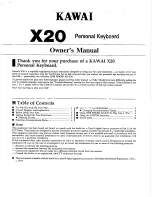
38
Creating a Patch
*
When TYPE 2–10 is selected and one tone of a pair is turned off, the other tone will be sounded as TYPE 1 regardless of the displayed setting.
Functions of Patch Parameters
Changing How a Tone Is Sounded (Structure)
Parameter
Value
Explanation
Struct 1 & 2, 3 & 4
(Structure Type)
TYPE 01–TYPE 10
Determines how tone 1 and 2, or tone 3 and 4 are connected.
The following 10 different Types of combination are available.
With this type, tones 1 and 2 (or 3 and 4) are independent. Use this type
when you want to preserve PCM sounds or create and combine
sounds for each tone.
This type stacks the two filters together to intensify the characteristics
of the filters. The TVA for tone 1 (or 3) controls the volume balance be-
tween the two tones.
This type mixes the sound of tone 1 (3) and tone 2 (4), applies a filter,
and then applies a booster to distort the waveform.
This type applies a booster to distort the waveform, and then combines
the two filters. The TVA for tone 1 (or 3) controls the volume balance
between the two tones and adjusts booster level.
This type uses a ring modulator to create new overtones, and com-
bines the two filters. The tone 1 (3) TVA will control the volume bal-
ance of the two tones, adjusting the depth of ring modulator.
This type uses a ring modulator to create new overtones, and in addi-
tion mixes in the sound of tone 2 (4) and stacks the two filters. Since
the ring-modulated sound can be mixed with tone 2 (4), tone 1 (3) TVA
can adjust the amount of the ring-modulated sound.
This type applies a filter to tone 1 (3) and ring-modulates it with tone
2 (4) to create new overtones.
This type sends the filtered tone 1 (3) and tone 2 (4) through a ring
modulator, and then mixes in the sound of tone 2 (4) and applies a fil-
ter to the result.
This type passes the filtered sound of each tone through a ring modu-
lator to create new overtones. The tone 1 (3) TVA will control the vol-
ume balance of the two tones, adjusting the depth of ring modulator.
This type passes the filtered sound of each tone through a ring modu-
lator to create new overtones, and also mixes in the sound of tone 2 (4).
Since the ring-modulated sound can be mixed with tone 2 (4), tone 1
(3) TVA can adjust the amount of the ring-modulated sound.
TONE 1 (3)
TONE 2 (4)
TVA
TVF
WG
WG
TVF
TVA
TYPE 1
TONE 1 (3)
TONE 2 (4)
TVA
TVF
WG
WG
TVF
TVA
TYPE 2
TONE 1 (3)
TONE 2 (4)
TVA
TVF
WG
WG
TVF
TVA
B
TYPE 3
TONE 1 (3)
TONE 2 (4)
TVA
TVF
WG
WG
TVF
TVA
B
TYPE 4
TONE 1 (3)
TONE 2 (4)
TVA
TVF
WG
WG
TVF
TVA
R
TYPE 5
TONE 1 (3)
TONE 2 (4)
TVA
TVF
WG
WG
TVF
TVA
R
TYPE 6
TONE 1 (3)
TONE 2 (4)
TVA
TVF
WG
WG
TVF
TVA
R
TYPE 7
TONE 1 (3)
TONE 2 (4)
TVA
TVF
WG
WG
TVF
TVA
R
TYPE 8
TONE 1 (3)
TONE 2 (4)
TVA
TVF
WG
WG
TVF
TVA
R
TYPE 9
TONE 1 (3)
TONE 2 (4)
TVA
TVF
WG
WG
TVF
TVA
R
TYPE 10
Fantom-Xa_e.book 38 ページ 2004年10月22日 金曜日 午後2時3分
















































